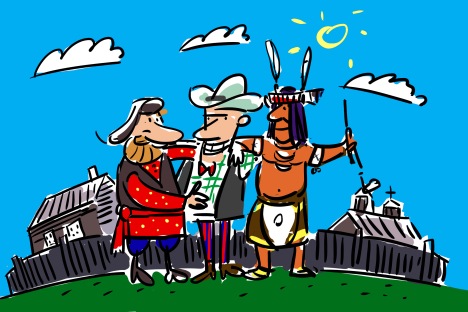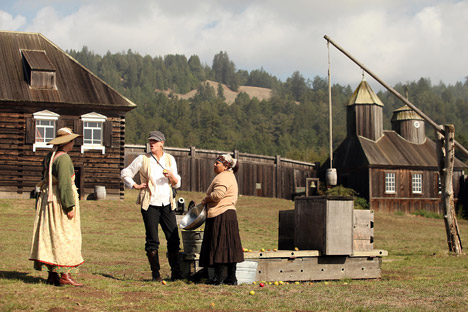Protecting our shared history at Fort Ross

Click to enlarge the image. Drawing by Iorsh
My colleague and I have just returned from several weeks in Russia, where we traveled to rural Pskov and Izborsk on the Estonian border, historic St. Petersburg, and bustling Moscow.
Whether walking the cobblestone streets along a 16th-century fortress or attending a meeting in one of Moscow’s modern glass and steel business centers, we marveled at the depth of historic experience these lands have witnessed and the ways in which Russians maintain respect for their past. Over the past decade, I’ve made trips to Russia to collaborate on a historic project important to both countries: Fort Ross State Historic Park.
I run a small nonprofit that supports Fort Ross, the 19th-century Russian settlement in Northern California just 80 miles north of San Francisco, where from 1812-1842 Russians tried their hand at farming, ranching and marine mammal hunting along the hospitable Alta California coast.
By 19th-century standards, Fort Ross was a relatively peaceful multicultural settlement. Russians ran the colony for slightly more than three decades and left a strong legacy, as manifested by the historic buildings and cemetery, and the various Sonoma county place names such as “Russian Gulch” and “Russian River.”
During our recent travels, we talked to Russians who had never visited America but were familiar with the Fort Ross story through the Internet and popular movie depictions. Russians universally expressed their gratitude that despite the last century of rocky U.S.-Russian relations, Americans willingly invested time and money to preserve and reconstruct the Russian-era buildings at Fort Ross.
Fort Ross-Seaview Harvest Festival on October 17th
Harvest Festival starts out with a morning of gentle apple picking in the historic orchard, where visitors can harvest fruit while enjoying the Eastern European harmonies of Kitka Women's Ensemble and Russian House Kedry.
The celebration then moves to the historic Fort Ross compound, where everyone can enjoy the old-world charm of the 19th century Russian settlement.
California State Parks do an excellent job and the park, situated on the pristine Northern California coastline with jaw-dropping views of the Pacific Ocean, is visually stunning. It is quiet and peaceful, with just enough infrastructure to suggest its rich past, but not so much development that it obscures reflection. The land itself truly draws people in.
Then, as now, Fort Ross continues to build bridges in important ways. For the Kashia Pomo, the First People who gave permission to the Russians to build the settlement, it is still home. Alaska Natives too find it an important gathering place. Americans are curious and fascinated to learn that Russians colonized Northern California – and that at Fort Ross, the slogan “The Russians are Coming” actually came to pass.
But for Russian Americans, especially diaspora Russians who fled Russia between the 1917 Revolution and the end of the Cold War, Fort Ross was as close to Mother Russia as these immigrants could experience. Fort Ross was, for many, a surrogate homeland.
This year, amid heightened tension and what many perceive as a new Cold War, I was relieved to witness that Fort Ross remains neutral territory, the Switzerland of the United States.
Californians still volunteer at the park with enthusiasm, and Russian individuals and corporations still support and promote it from afar. For the Russians, perhaps, support is motivated by their desire to show respect for their forebears, these early 19th-century explorers, buried at Fort Ross.
And Russians clearly take pride that during their tenure in California, Imperial Russia’s best scientists created the earliest maps, catalogued the native flora and fauna, sketched with artistry the people and places, named our state flower the California poppy, and planted the first grapes in Sonoma County, today the center of California’s rich viticulture industry.
Whatever the motivation, I can report that Russian enthusiasm to work with us on this common project is undiminished by current politics. Let us hope that a Cold War is impossible in the digital age, when communication crosses political boundaries and people learn about anything, including history, through modern technology.
My sense is that Russians want to work with Americans on common projects that reflect our shared history and our shared humanity, and no amount of media coverage can mask this desire.
Sarah Sweedler is the President and CEO of Fort Ross Conservancy in California.
More U.S.-related stories in your box!
All rights reserved by Rossiyskaya Gazeta.
Subscribe
to our newsletter!
Get the week's best stories straight to your inbox

